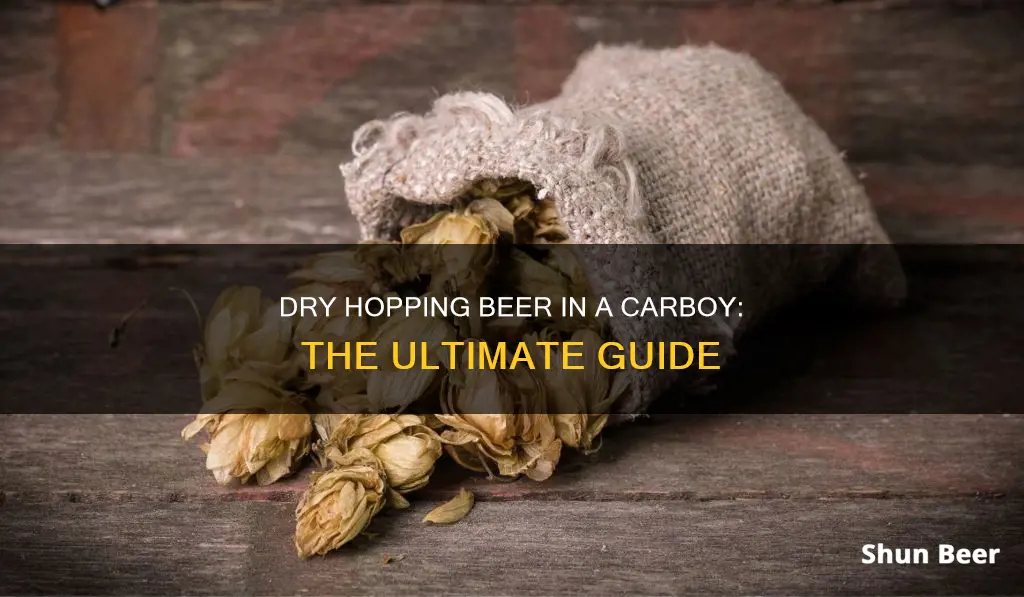
Dry hopping is the act of adding hops after the boil, and even after primary fermentation. It brings out the floral, fruity, and herby notes of hops without extracting all the bitterness from the plant. There are three options for dry hopping in a carboy: loose during primary fermentation, contained during primary fermentation, or contained during secondary fermentation. The first option involves dropping hops into the carboy once the wort cools down and allowing fermentation to take place alongside the hops. The second option involves containing hops in a mesh bag or cheesecloth during primary fermentation, which allows for easier separation from the wort. The third option is to wait until the secondary fermentation process, which ensures the least amount of bitterness as the hops are added late in the process.
How to dry hop beer in a carboy
| Characteristics | Values |
|---|---|
| What is dry hopping? | Dry hopping is the act of adding hops after the boil, and even after primary fermentation. |
| Why dry hop? | To bring out the floral, fruity, and herby notes without extracting bitterness from the hops. |
| When to dry hop? | There are four stages: before fermentation (hopback), during fermentation (primary fermentation), after fermentation (secondary fermentation), or in the keg (packaging). |
| How to dry hop in a carboy? | Three options: loose during primary fermentation, contained during primary fermentation, or contained during secondary fermentation |
| Loose during primary fermentation | Drop hops into the carboy when the wort cools down and allow fermentation to take place. Filter out the hops with yeast when racking the beer. |
| Contained during primary fermentation | Contain hops in a mesh bag or cheesecloth to steep in the wort, then pull out the hops before moving to secondary fermentation. |
| Contained during secondary fermentation | Wait to add hops until after racking and extracting sediment to ensure the least amount of bitterness. Keep hops in a mesh bag or cheesecloth. |
| Other considerations | The secondary fermenter is considered the best place for dry hopping as alcohol and low pH help ward off bacteria on the un-sanitized hops. |
What You'll Learn

Contained vs. loose dry hopping
When it comes to dry hopping in a carboy, you have three options: loose during primary fermentation, contained during primary fermentation, or contained during secondary fermentation.
Loose During Primary Fermentation
Loose dry hopping during primary fermentation involves adding hops directly to the carboy once the wort has cooled and allowing fermentation to take place alongside the hops. The longer the hops sit in the wort, the more bitterness they will impart. When it's time to rack your beer, you'll need to filter out the loose hops along with the yeast, which can make cropping yeast more challenging.
Contained During Primary Fermentation
If you want to crop your yeast separately, you can contain your hops in a mesh bag or cheesecloth during primary fermentation. This allows the hops to steep fully in the wort without mixing with the yeast. When it's time to rack your beer, simply remove the hops in the cheesecloth and proceed to secondary fermentation.
Contained During Secondary Fermentation
You can also choose to wait until secondary fermentation to add your hops. This option ensures the least amount of bitterness, as the hops are added late in the process. Keep the hops in a mesh bag or cheesecloth to prevent them from floating freely in the beer, and remove them before bottling or kegging.
Advantages and Disadvantages
Loose dry hopping allows for better contact between the hops and the beer, potentially resulting in more intense flavours and aromas. However, it can be challenging to remove all the hop material, especially when transferring to a keg. Contained dry hopping, on the other hand, makes it easier to separate the hops from the beer but may reduce the surface area of the hops exposed to the beer, potentially impacting flavour extraction.
Dry Hopping Beer Twice: A Guide to Enhancing Aroma and Flavor
You may want to see also

Dry hopping during fermentation
There are a few benefits to dry hopping during fermentation. Firstly, it can help to avoid oxidising the beer when introducing the hops into the solution. Secondly, the yeast present during fermentation can metabolise any oxygen introduced before it is able to cause any negative effects. Finally, the fermentation process can alter some oil compounds, like terpenes, into more volatile and flavour-active ones, enhancing the beer's aromatic quality.
However, there are also some potential downsides to dry hopping during fermentation. The CO2 created by fermentation can strip away the desired volatile compounds. Additionally, there is a risk of a "beer volcano", where too many CO2 bubbles cluster into nucleation sites in the hop particles and burst out of the tank. Furthermore, the potential for hop compounds to be bound to the yeast and dropped out of the beer after fermentation is high, which can reduce the amount of polyphenols in the finished beer.
When dry hopping during fermentation, it is important to leave some room at the top of the tank and add the hops slowly to avoid overflow. Brewers can also create a hop slurry by combining the hops with a small amount of beer and then shooting it into the full batch. This technique helps manage the challenges associated with dry hopping during active fermentation.
Overall, dry hopping during fermentation can be a great way to experiment and create a unique beer with enhanced aromatic qualities.
The Historical Addition of Hops to Beer
You may want to see also

Dry hopping after fermentation
The hops will find a different environment after fermentation. The vigorous CO2 bubbling of primary fermentation is finished, so the hops won’t lose their aroma compounds to scrubbing. And bacterial contamination is less of a threat since the wort has a higher alcohol content, less available oxygen, and lower pH.
However, the biggest risk of dry hopping after fermentation is introducing unwanted oxygen. You also run the risk of "hop creep", which is a phenomenon where dry-hopping results in more fermentation. To prevent hop creep, simply lower the fermentation temperature to 58º F (14.5º C).
There are a few different methods for dry hopping after fermentation. One is to add the hops directly to the carboy, without a bag. Then, when you rack from the carboy to the bottling bucket or keg, you can put cloth (such as cheesecloth) around the siphon tip, held in place by floss or a clean rubber band.
Another method is to use a bag to contain the hops. You can use a muslin or nylon bag, or a stainless steel mesh tube. This will limit cleanup and avoid clogging the airlock, blow-off tube, and siphon hose. However, this method limits hop flavour and will still add oxygen.
If you are using a stainless steel fermenter, you can use a magnet to hold the bag of hops above the beer inside the fermenter. When fermentation is complete, remove the magnet from the outside of the fermenter and the hop sack will drop into the beer, avoiding oxygen.
Hops' Magic: Brewing Beer's Unique Flavors
You may want to see also

Dry hopping in a keg
Dry hopping is a great way to impart a strong hop aroma to beer. The process involves adding hops to the beer after it has been cooled, and it can be done in the primary or secondary fermenter, or directly in the keg.
When dry hopping in a keg, it is recommended to use a muslin or cheesecloth bag to contain the hops. This will prevent hops from being sucked into the system and causing clogs. One concern with dry hopping in a keg is the extended duration of contact between the hops and the beer. Some brewers feel that if the hops are left in the beer for more than a few weeks, the beer may develop a "grassy" flavour. However, others have left hops in their kegs for up to six weeks without any issues.
To avoid potential grassy flavours, it is recommended to limit the exposure time of the hops to the beer to about a week. The uptake of hop aromatics happens quickly, and anything longer than five days may not significantly increase the hoppiness of the beer. Prolonged exposure to hop matter may result in the extraction of flavours that are perceived as grassy or astringent.
When choosing hops for dry hopping, it is important to select a variety with a pleasant aroma. It is recommended to smell the hops before deciding whether to use them, as canned descriptions may not always be accurate. It is also important to consider the timing of dry hopping. Adding hops towards the tail end of fermentation can help minimise the risk of oxidising the beer.
Bock Beer and Hops: A Complex Relationship
You may want to see also

Dry hopping with a bag
Dry hopping is the process of adding hops to beer after the boil to enhance its aroma and flavour without increasing bitterness. When dry hopping with a bag, it is important to consider the type of hops, the amount, the timing, and the bag material.
Type of Hops
The type of hops used for dry hopping is crucial. Aroma-forward hops with low alpha acid ratings, such as Cascade, Centennial, Citra, and Mosaic, are commonly chosen for their ability to impart desirable flavours and aromas. However, it is important to select hops that complement the beer's flavour profile and characteristics.
Amount of Hops
The amount of hops added during dry hopping depends on the desired intensity of flavour and aroma. A general guideline is to use between 0.5 and 4 ounces of hops per 5 gallons of beer. For American pale ales, 0.5 to 1 ounce is often sufficient, while IPAs may use up to 2 ounces, and double IPAs can handle up to 4 ounces.
Timing of Dry Hopping
The timing of dry hopping can vary. Some brewers prefer to add hops during primary fermentation, taking advantage of the active yeast to transform hop oil compounds and create unique flavours and aromas. Others opt for dry hopping after fermentation to minimise the loss of aroma compounds. The ideal duration for dry hopping is about 48 to 72 hours, as longer periods may result in vegetal or grassy flavours.
Bag Material
When using a bag for dry hopping, it is recommended to use a muslin, nylon, or stainless steel mesh bag. These bags help contain the hops, making it easier to separate them from the beer during racking or bottling. However, it is important to sanitise the bag before use to prevent contamination.
Dry Hopping Beer: Timing and Techniques for Flavorful Brews
You may want to see also
Frequently asked questions
There are three options for dry hopping in a carboy – loose during primary fermentation, contained during primary fermentation, or contained during secondary fermentation.
Dry hopping preserves the essential oils in the hops instead of boiling them away or letting them drop out. This results in a massive blast of floral and fruity flavours and aromas.
Some beer drinkers think it makes the beer taste "grassy" or "oily". There is also a risk of introducing oxygen into the beer, which can cause oxidation.
This depends on personal preference. John Palmer recommends dry hopping your homebrew with "3 to 5 days contact time", while Charlie Papazian says you can dry hop your beer for "1 to 2 weeks" before bottling or kegging.







